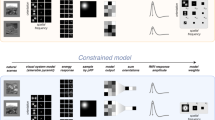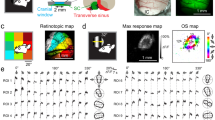Abstract
A method for measuring local rates of glucose uptake in mammalian brain tissue1,2 has been used to study monkey cortex receiving visual stimulation through one eye3. The resulting pattern of glucose uptake resembled that of the ocular dominance columns, identified by several independent methods in the cortex4–6. In addition, the pattern of glucose uptake produced by binocular viewing of stripes of a single orientation7–12 was consistent with the arrangement of orientation columns expected from the sequence of preferred orientations of single cells recorded in the visual cortex4,13–16. It was therefore assumed that the columns of glucose uptake revealed in the studies of orientation selectivity correspond to columns of cortical cells selective for the orientation viewed. Recent findings about the monkey visual cortex led us to question this assumption.17–20 We have now investigated this question in the cat by making microelectrode recordings to determine preferred orientation of cortical units at known positions within the visual cortex and then stimulating the same animals with a full-field pattern of stripes to measure the rates of glucose uptake at the positions of each of the cortical units. As in previous studies, preferred orientation shifted gradually and progressively along electrode tracks parallel to the cortical surface4,13–16 and a pattern of densely labelled columns was observed in the 2-deoxyglucose autoradiographs7–12. The centres of densely labelled cortical columns contained cells selective for the stimulated orientation. Preferred orientation shifted gradually away from the stimulated orientation at sites progressively more distant from the centres of the columns. Control experiments revealed no columns after stimulation with a pattern of changing orientation. Thus the columns revealed by the deoxyglucose method do correspond to the physiological orientation columns.
This is a preview of subscription content, access via your institution
Access options
Subscribe to this journal
Receive 51 print issues and online access
$199.00 per year
only $3.90 per issue
Buy this article
- Purchase on Springer Link
- Instant access to full article PDF
Prices may be subject to local taxes which are calculated during checkout
Similar content being viewed by others
References
Kennedy, C. et al. Science 187, 850–852 (1975).
Sokoloff, L. et al. J. Neurochem. 28, 897–916 (1977).
Kennedy, C. et al. Proc. natn. Acad. Sci. U.S.A. 73, 4230–4234 (1976).
Hubel, D. H. & Wiesel, T. N. J. Physiol., Lond. 195, 215–243 (1968).
Wiesel, T. N., Hubel, D. H. & Lam, D. M. K. Brain Res. 79, 273–279 (1974).
LeVay, S., Hubel, D. H. & Wiesel, T. N. J. comp. Neurol. 159, 559–576 (1975).
Hubel, D. H., Wiesel, T. N. & Stryker, M. P. J. Comp. Neurol. 177, 361–380 (1978).
Stryker, M. P., Hubel, D. H. & Wiesel, T. N. Abstr. Soc. Neurosci. 3, 1852 (1977).
Humphrey, A. L., Skeen, L. C. & Norton, T. T. J. comp. Neurol. 192, 549–566 (1980).
Singer, W. Expl Brain Res. 41, 199–215 (1981).
Albus, K. Expl Brain Res. 37, 609–613 (1979).
Flood, D. G. & Coleman, P. D. Brain Res. 173, 538–542 (1979).
Hubel, D. H. & Wiesel, T. N. J. Physiol., Lond. 165, 559–568 (1963).
Hubel, D. H. & Wiesel, T. N. J. comp. Neurol. 158, 267–294 (1974).
Albus, K. Expl Brain Res. 24, 181–202 (1975).
Humphrey, A. L. & Norton, T. T. J. comp. Neurol. 192, 531–547 (1980).
Hendrickson, A. E. & Wilson, J. R. Brain Res. 170, 353–358 (1979).
Horton, J. C. & Hubel, D. H. Abstr. Soc. Neurosci. 6, 315 (1980).
Humphrey, A. L. & Hendrickson, A. E. Abstr. Soc. Neurosci. 6, 315 (1980).
Hendrickson, A. E., Hunt, S. & Wu, J. Y. Abstr. Soc. Neurosci. 6, 671 (1980).
Hubel, D. H. Science 125, 549–550 (1957).
Ross, M. J. & Stroud, R. M. Acta crystallogr. A33, 500–508 (1977).
Schoppmann, A. & Stryker, M. P. Abstr. Soc. Neurosci. 6, 314 (1980).
Author information
Authors and Affiliations
Rights and permissions
About this article
Cite this article
Schoppmann, A., Stryker, M. Physiological evidence that the 2-deoxyglucose method reveals orientation columns in cat visual cortex. Nature 293, 574–576 (1981). https://doi.org/10.1038/293574a0
Received:
Accepted:
Issue Date:
DOI: https://doi.org/10.1038/293574a0
This article is cited by
-
Opposite impact on 14C-2-deoxyglucose brain metabolism following patterns of high and low frequency repetitive transcranial magnetic stimulation in the posterior parietal cortex
Experimental Brain Research (2007)
-
Impact of repetitive transcranial magnetic stimulation of the parietal cortex on metabolic brain activity: a 14C-2DG tracing study in the cat
Experimental Brain Research (2005)
-
Inhibition contributes to orientation selectivity in visual cortex of cat
Nature (1988)
-
The determination of the local cerebral glucose utilization with the 2-deoxyglucose method
Histochemistry (1988)
-
Local cerebral glucose utilization in the Ammon's horn and dentate gyrus of the rat brain
Histochemistry (1988)
Comments
By submitting a comment you agree to abide by our Terms and Community Guidelines. If you find something abusive or that does not comply with our terms or guidelines please flag it as inappropriate.



